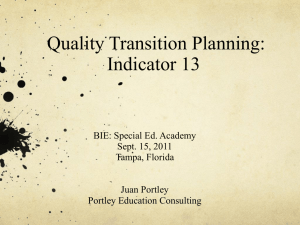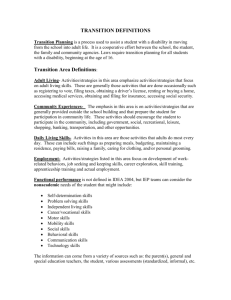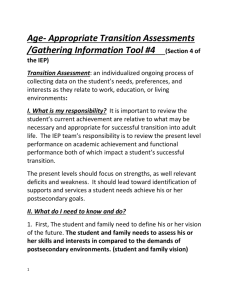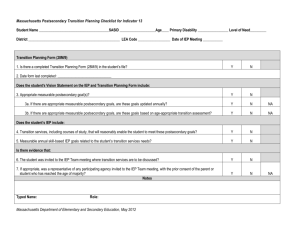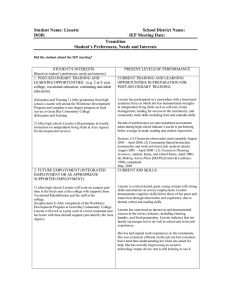Transition Assessment - GADOE Georgia Department of Education
advertisement
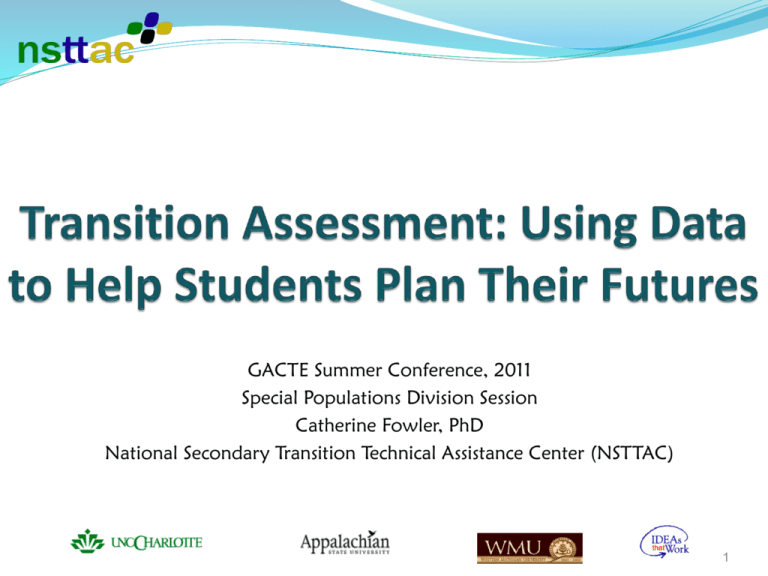
GACTE Summer Conference, 2011 Special Populations Division Session Catherine Fowler, PhD National Secondary Transition Technical Assistance Center (NSTTAC) 1 Session Purpose Increase knowledge of transition planning process – connecting the compliance dots for quality transitionfocused IEPs Increase awareness of types and areas of transition assessment Increase awareness of quality tools (formal or informal) currently using – or available – to gather pertinent transition assessment data Increase knowledge of writing measureable postsecondary goals from transition assessment data IDEA 2004 Beginning not later than the first IEP to be in effect when the child turns 16, or younger if determined appropriate by the IEP Team, and updated annually, thereafter, the IEP must include— (1) Appropriate measurable postsecondary goals based upon age appropriate transition assessments related to training, education, employment, and, where appropriate, independent living skills; and (2) The transition services (including courses of study) needed to assist the child in reaching those goals State of Georgia Rule Transition service plan will be completed not later than the first IEP to be in effect when the student enters in the 9th grade, or 16 years old, or younger if deemed appropriate by IEP team and updated annually. A Transition-Rich IEP Transition Assessment & Present Level of Achievement Designated Responsibility Measurable Postsecondary Goals Annual Goals Transition Services including Courses of Study 5 Seattle University - Center for Change in Transition Services, 2010 Defining Transition Assessment The ongoing process of collecting data on the individual’s needs, preferences, and interests as they relate to the demands of current and future working, educational, living, and personal and social environments Transition Assessment Should Address Three Areas Independent Living Employment Education/ Training Transition Assessment Areas • Self-Determination Skills • Independent Living Skills • Career & Vocational Interests & Skills • Academic Skills Types of Transition Assessments Formal and Informal Formal: • To learn about a wide variety of skill levels in various areas (e.g., vocational, academic, social) • Published tests: scores that compare students to others • Usually some level of research to support development (best) Types of Formal Assessments • Learning style inventories • Academic achievement tests (Woodcock Johnson) • Adaptive behavior scales (Vineland) • Aptitude tests (Differential Aptitude Test) • Interest inventories (Self-Directed Search [Forms E, R, and Explorer] Informal: • Observing the student in various academic and work experiences • Talking with the student about likes and dislikes • Setting up experiences to allow the student to try something that that may be of interest • Often teacher-made • Often does not result in a score Types of Informal Assessments • Observation: watching or listening to an individual’s behavior and recording relevant information • Interviews/ Questionnaires: structured or unstructured conversations through questionand-answer format • Environmental Analysis: carefully examining the environment in which an activity normally occurs • Curriculum based assessments: task-analysis, portfolio assessments, work sample analysis, criterion-referenced tests (Test, Aspel, & Everson, 2006 - Transition Methods for Youth with Disabilities) What do you use? What’s available to you? What do you like about the tool(s) you’re using? How does the information help you assist students in identifying their goals? Self-Determination Assessments AIR Self-Determination Assessment Formal Self-Determination Assessment Parent, Teacher Version, and Student Version Available at: www.ou.edu/zarrow/sdetermination.html www.sdtac.uncc.edu Cost: free Choice-Maker Informal Self-Determination Assessment Curriculum Referenced Assessment Choosing Goals Participating in IEP Meetings Taking Action on Goals Sopris West (search by author: Martin) www.sopriswest.com Cost: $12.95 for 25 copies Self-Determination Assessments • AIR – Self-Determination Assessment (free) • ARC Self-Determination Scale (free) • Choice Maker Self-Determination Assessment • Field and Hoffman Self-Determination Battery if Teacher Made Disability awareness? Knowledge of rights? Ability and opportunity to make choices? Weigh options and make decisions? Identify steps toward a goal? Identify solutions/ steps to overcome barriers, negotiate problems? Manage timelines? Monitor own behaviors? Independent Living Skills Assessments Transition Planning Inventory (informal) •Comprehensive system •School, parent, and student form •“Further assessment” tools •Now offers a tool for students with more severe intellectual disabilities •Intended to feed directly into identifying postsecondary goals and annual goals •Clark & Patton •Full = $200, components $29 - $38 •www.proedinc.com Casey Life Skills (formal) Spanish or English, with numerous supplemental assessments Youth and caregiver formats Automatically scored and sent to you Can obtain class summaries Provides different levels of questions for students across functioning levels Ansell-Casey Foundation Free www.caseylifeskills.org Brigance Transition Skills Inventory (informal) Middle and high school students Curriculum based measure TSI Kit $259.00 Transition Skills Inventory $199.00 TSI Record Books 10-Pack $35.00 Brigance Transition Skills Inventory • • • • • • • • • • • • • • Pre-employment/functional writing Career awareness Job-seeking Post-secondary opportunities Functional reading Speaking and listening Math Money and finance Technology Housing Food and clothing Health Travel and transportation Community resources Supports Intensity Scale (formal) Evaluates support requirements of a person with an intellectual disability Interview format Ranks each activity according to frequency (none, at least once a month), amount (none, less than 30 minutes), and type of support (monitoring, verbal gesturing) $150.00 (available on CD for $350.00) www.siswebsite.org Teacher Made Assessments Family/ caregiver interviews Student interviews Observations – task analysis Think beyond residential independence – think “adult living” Vocational/ Career Exploration Assessments Career Interests Self-Directed Search (formal) Inventory of career interests Series of “likes” and “dislikes” results in a profile of career types (e.g., realistic, artistic) 3 different forms for different reading levels Profile corresponds to Occupational Outlook Handbook careers Holland 1-99 Uses, $4.95 per report (online); $12 + $5 for extra assessment pack – and now “there’s an app” O*NET O*NET Ability Profiler O*NET Interest Profiler O*NET Computerized Interest Profiler US Department of Labor $52/ 25 copies, $7 - $22 for additional materials www.onetcenter.org : “products” Strong Campbell Interest and Skill Survey (CISS) 25 minutes (200 interest and 120 skill items, 6-point response scale); online management; 6th grade reading level Influencing: Leadership, Law/Politics, Public Speaking, Sales, Advertising/Marketing Organizing: Supervision, Financial Services, Office Practices Helping: Adult Development, Counseling, Child Development, Religious Activities, Medical Practice Creating: Art/Design, Performing Arts, Writing, International Activities, Fashion, Culinary Arts aNalyzing: Mathematics, Science Producing: Mechanical Crafts, Woodworking, Farming/Forestry, Plants/Gardens, Animal Care Adventuring: Athletics/Physical Fitness, Military/Law Enforcement, Risks/Adventure $11.50 - $16.75/ administration SSQ from Myers Briggs (formal) Student Styles Questionnaire Introversion/Extraversion; Thinking/Feeling; Practical/Imaginative; Organised/Flexible Students respond to 69 questions related to real-life situations to express their individual styles 8 – 17 year olds, ~ 30 minutes, written or read-aloud Pearson, $195 for full test kit, computer or handscoring YES! (Your Employment Selections) Informal Transition Assessment • Reading free, video based job preference program • Videos for 120 jobs • Accessed by characteristics or job choices • Matched to training and qualifications • Can access from CD ($395) or web ($20 per person for 3 months) • www.yesjobsearch.com Career Aptitude ASVAB (formal) Armed Services Vocational Aptitude Battery ASVAB Career Exploration Program For students who are interested in military service (Free) OASIS – 3 (formal) Occupational Aptitude Survey and Interest Schedule Vocabulary, Computation, Spacial-Relation, Word-Comparison sections of written test Formal assessment Test booklets, examiners manual, and interpretative manual Published by ProEd, $191.00 DAT (formal) Differential Aptitude Test for Personnel and Career Assessment Verbal Reasoning, Numerical Reasoning, Mechanical Reasoning, Abstract Reasoning, Language Usage (6 – 20 minutes/ section) Formal assessment Each component sold as own test packet Pearson - ~$165/ component or $6/ online Wiessen (formal) Wiessen Test of Mechanical Aptitude (WTMA) ability to learn to use and maintain equipment and machinery to predict performance for occupations involving the operation, maintenance, and servicing of tools, equipment, and machinery a 30-minute, 60-item test 6th grade reading level Annual subscription fee OR ~$200 paper set Teacher-Made Assessments Task analysis Job coach or supervisor checklist Co-worker checklist Student interview Student self-assessment/ self-monitoring sheet Related course performance (e.g., welding, child-care and first-aid) Skill Set The composite work behaviors and skills we offer a potential employer Prospective employees need to be able to describe their skill set relative to a given job in an interview context They also need to be prepared to demonstrate their skill set if given a job try out What do you use? What’s available to you? What do you like about the tool(s) you’re using? How does the information help you assist students in identifying their goals? Additional Resources www.bls.gov/oco/home.htm (Occupational Outlook Handbook) http://acinet.org/acinet/videos.asp (watch videos about jobs) Georgia College 411 – Georgia Work Ready U.S. Department of Labor Academic Assessments Achievement tests Curriculum based measures Formal measures used for eligibility Observation … Activity! Review packet of sample assessments Think, pair, share Select one tool What information can you gather from this tool? (don’t worry about scoring) What would this help you know/ do with your student? What other information would you need to gather to help them plan for their future? Seattle University - Center for Change in Transition Services, 2010 Postsecondary Goals Measurable = Countable Identifies an outcome, not a process One goal for each adult outcome area Adult Outcome Areas Education and Training (required) Employment (required) Independent Living (when appropriate) 47 Postsecondary Goal Questions Where is the student going to work or engage in productive activities after graduation? Where and how is the student going to continue to learn and/or develop skills after graduation? Where is the student going to live and how is he or she going to access adult services, participate in the community and have fun after graduation? A Helpful Formula ____________ _______ will ______ ______ After high school After graduation Upon completion of high school The Student Behavior (Where and how) Jamarreo demonstrated proficiency on all end of course exams required for 10th and 11th grade. audiological evaluation was completed as part of the three year reevaluation. informal interview with his family in preparation for the IEP meeting, mother noted concerns about Jamarreo’s lack of concern for legal consequences Self Directed Search completed March, 2009 suggest Jamarreo has strengths in the area of mechanical work 50 Examples of Postsecondary Goals Education/Training: Upon graduation from high school, Jamarreo will attend (Central Piedmont) Community College (and participate in the welding industry certificate program meeting the requirements to attain an Entry Level Welding Certificate). Employment: Upon graduation from high school, Jamarreo will work part-time (as a shop helper in his uncle’s shop to gain experience in the automotive repair industry). 51 Examples of Postsecondary Goals Independent Living: After graduation, Jamarreo will follow the laws of his community, (demonstrating an understanding of the need for laws to ensure his and others’ safety). 52 Jason 16 years old Bright, friendly student with a specific learning disability in reading and reading comprehension On Saturdays during the school year, he earns spending money by working in his uncle’s legal firm, answering the telephone and filing various documents. Jason plans to be a high school social studies teacher Jason knows he needs to access disability support services on a college campus, but is unhappy about disclosing his disability to his professors. He would prefer that his high school guidance counselor send a letter to his professors so he does not have to engage in a conversation about his disability Examples of Postsecondary Goals Education/Training: After graduating from high school, Jason will attend a four-year college to obtain his undergraduate degree in history and education, to become a high school social studies teacher. Employment: After obtaining his degree from the university, Jason will work as a high school history teacher in his hometown. 54 Examples of Postsecondary Goals Independent Living: After graduation, Jason will advocate for any accommodations he needs to be successful in his further education and employment. 55 Jodi an evaluation completed by one of Jodi’s employers regarding her performance during the fall semester indicated she demonstrated positive workplace behaviors with some concerns about excessive talking completed the Brigance Employability Inventory with the transition coordinator one year prior to this IEP that indicated that Jodi prefers social careers where she can be around people overall IQ in the upper limits of the Borderline Intellectually Deficient Range, with commensurate academic skills in reading/ math 56 Examples of Postsecondary Goals Education/Training: (The fall) after high school, Jodi will attend the (Customer Service Representative course offered through the Pathways to Employment program at Central Piedmont) Community College. Employment: (Within three months) after graduation, Jodi will be competitively employed, (working 20 or more hours, in a in the retail industry with time limited supports of a job coach). Lissette A 20 year old student with Down Syndrome Has had several surgeries to correct scoliosis. She now walks at an average speed, but she uses a cane for stability Wants to attend Montgomery County Community College to take courses to gain skills related to functional academics and career preparation Participated in several unpaid work training experiences in the community through her high schoolAt the job site, she was extremely efficient, but her co-workers had difficulty understanding her requests when she asked for help. Expressed an interest in jobs related to the food service industry, cleaning, and laundry Not had her own bank account, but she has some experience managing small amounts of money she received as a gift or for chores Examples of Postsecondary Goals Education/Training: After high school, Lissette will participate in weekly instruction on community integration and employment skills at the local community college Employment: After high school, Lissette will work on-campus part-time in the food court at the college with supports from Vocational Rehabilitation Examples of Postsecondary Goals Independent Living: After high school, Lissette will live semi-independently with a roommate (in an assisted living apartment with supports provided through Disability Services) Upon completion of high school, Lissette will utilize public transportation, including the public bus and trolley with time limited supports provided through Vocational Rehabilitation 60 Let’s Practice! Articulate a post secondary goal in employment for the following case study. Carlos is a 19 year old student identified with emotional and behavioral disabilities. Carlos’ interpersonal skills and work ethic are strengths for him. He enjoys working with other young men, doing manual labor, and listening to loud music while working. He exhibits strengths in the area of mechanical work. Career assessments indicate that he is likely to be a serious, dedicated employee. At home, he fixes appliances around the house, which his mother appreciates. ____________ _______ will ______ ______ (After high school) (After graduation) (Upon completion of high school) (The Student) (Behavior) (Where and how) How does this sound? Carlos is a 19 year old student identified with emotional and behavioral disabilities. Carlos’ interpersonal skills and work ethic are strengths for him. He enjoys working with other young men, doing manual labor, and listening to loud music while working. He exhibits strengths in the area of mechanical work. Career assessments indicate that he is likely to be a serious, dedicated employee. At home, he fixes appliances around the house, which his mother appreciates. After graduation Carlos Work as a repairman for a local appliance store. ____________ _______ will ______ ______ (After high school) (After graduation) (Upon completion of high school) (The Student) (Behavior) (Where and how) Transition Services Should focus on academic and functional achievement to facilitate movement from school to post-school life For each postsecondary goal, transition services may include: Instruction Related Services Community Experience Development of Employment and Post-School Objectives Acquisition of Daily Living Skills (if appropriate) Functional Vocational Evaluation (if appropriate) 63 What activities did you do in high school? Remaining IEP Components Courses of study Annual goals that support the transition services Other agencies invited (with consent) to the IEP meeting Student invited to the IEP meeting All should reflect transition assessment results Benefits of Transition Assessment (for Professionals) Identify student interests Identify outside factors that may help/ hinder a student’s career pursuit Identify academic or social supports needed for success in current environment(s) Engage students Benefits of Transition Assessment (for students) Make informed choices Take charge of the transition process Understand the skills needed for post-school environments You’re listening to me and interested in my future Benefits for Other Stakeholders Comprehensive information about a student Engaging them (other stakeholders) in the process Engaging students in their education plan Considerations Student engagement in the process Youthhood.org iTransition at PENET.org I’m Determined (VA Google this) Portfolio systems for college planning GACollege411 Students with severe disabilities – personcentered planning Formative, cyclical process More Considerations Time Resource, study skills, social studies, english language arts, career technical education Advisory Process for ALL students ….? What else? What challenges? Tips/Reminders Multiple sources, multiple areas, multiple times Age appropriate Student-centered Post-school focused (consider real environments) What you need to make your plan (what do you already collect?) Document enough on IEP to connect to PS Goals Individuals Involved in the Transition Assessment Process • • • • • Special Ed. Teachers Guidance Counselors Vocational Evaluators CTE Professionals Rehabilitation Professionals • Vocational Support Service Personnel • Students • • • • • • • School Psychologists Social Workers Employers Job Coaches Transition Coordinators Case Managers Parents Resources www.nsttac.org: Transition Assessment Toolkit www.nsttac.org: National Map, search “transition assessment” or click on Colorado, Iowa, North Dakota, West Virginia www.transitioncoaltion.org (login – resources, modules) Google Zarrow Center (several free) https://sites.google.com/site/transitionassessment/ http://www.pepnet.org/itransition.asp www.ALife4Me.org www.youthood.org Final Take Away Complete your evaluation! What will YOU use? Identify a toolbox of instruments that you can use with many students Use more when you need to drill further Share results with the student, their families, and your colleagues to improve transition planning Contact Us Catherine Fowler, chfowler@uncc.edu www.nsttac.org

